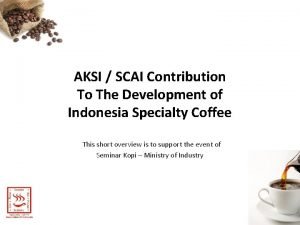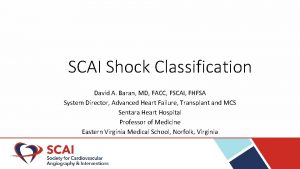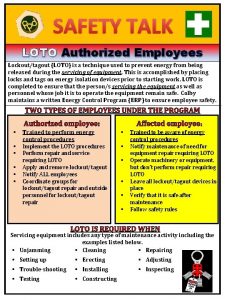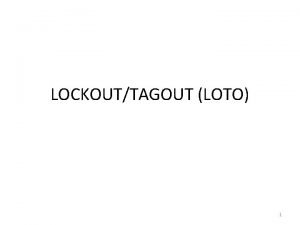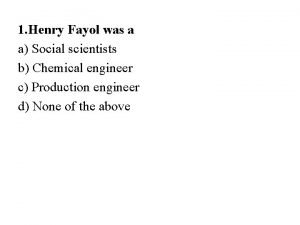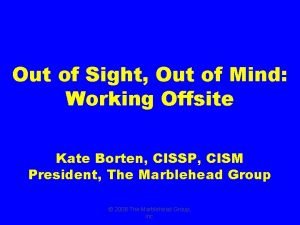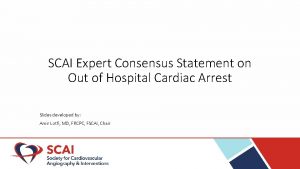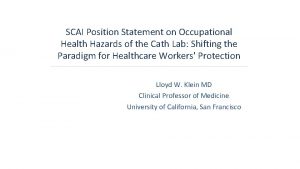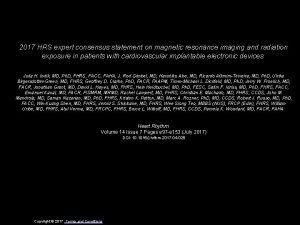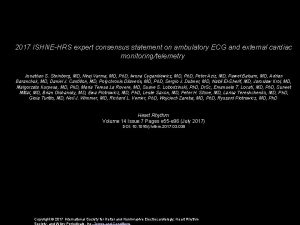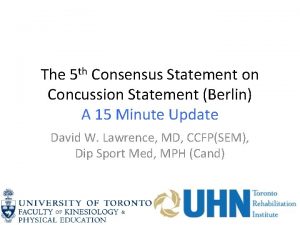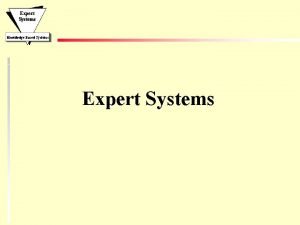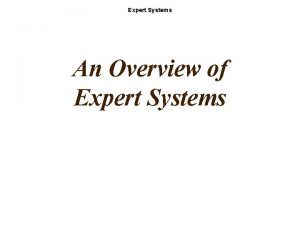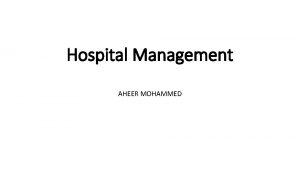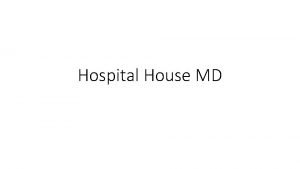SCAI Expert Consensus Statement on Out of Hospital

















- Slides: 17

SCAI Expert Consensus Statement on Out of Hospital Cardiac Arrest Amir Lotfi, M. D. FRCPC FSCAI Associate Chief, Cardiology Division Medical Director, Inpatient Heart & Vascular Medical Director, Baystate regional MI Program Associate Professor of Medicine, Tufts University School of Medicine May 14 , 2020

Disclosures None

Case • 59 year old woman • Hypertension • Class I obesity • Out of hospital cardiac arrest (OHCA) • • • Location Home Immediate by stander cardiopulmonary resuscitation by boyfriend 911 Emergency medical services (EMS) arrived with 5 minutes Automated external defibrillator (AED) – shockable rhythm-one shock discharged Total no flow and low flow time to return of spontaneous circulation (ROSC) 18 minutes

Electrocardiogram at the Hospital

Out of Hospital Cardiac Arrest • OHCA remains a significant public health problem with high mortality and morbidity • Interventional cardiologists are often consulted on OHCA patients with shockable rhythm and ROSC • The purpose of this document is to provide an evidence-based and patientoriented recommendation for the management of these patients

Background • Annual incidence of EMS-assessed OHCA • • • 347, 322 Location – home or residence in 69. 5%; Nursing home 11. 7% Witnessed by layperson 37% Survival to discharge 10. 4% with good functional status 8. 4% Shockable by an AED 18. 7% Benjamin EM, et al. Heart Disease and Stroke Statistics— 2019 Update. A Report from the American Heart Association. Circulation. 2019; 139: 00 CARES registry 2017

Etiology of Death • The rate of survival to discharge with good neurologic function among OHCA patients is low with wide geographical variation estimated at 0. 8 – 20%. • The cause of death in two-thirds of patients with OHCA is due to anoxic brain injury and another one-third is due to a refractory post arrest shock and multi-organ failure • Anoxic brain injury and post-cardiac arrest shock share common risk factors Laver S, Farrow C, Turner D, Nolan J. Mode of death after admission to an intensive care unit following cardiac arrest. Intensive Care Med 2004; 30: 2126 -8. Girotra S, van Diepen S, Nallamothu BK et al. Regional Variation in Out-of-Hospital Cardiac Arrest Survival in the United States. Circulation 2016; 133: 2159 -68. Lemiale V, Dumas F, Mongardon N et al. Intensive care unit mortality after cardiac arrest: the relative contribution of shock and brain injury in a large cohort. Intensive Care Med 2013; 39: 1972 -80.

• There is no single factor at the time of presentation to reliably prognosticate subsequent neurological outcome • There are risk scores to assist decision making in a time sensitive situation Geocadin RG, Callaway CW, Fink EL et al. Standards for Studies of Neurological Prognostication in Comatose Survivors of Cardiac Arrest: A Scientific Statement From the American Heart Association. Circulation 2019; 140: e 517 -e 542 Bougouin W, Dumas F, Karam N et al. Should We Perform an Immediate Coronary Angiogram in All Patients After Cardiac Arrest? : Insights From a Large French Registry. JACC Cardiovasc Interv 2018; 11: 249 -256. Bascom KE, Dziodzio J, Vasaiwala S et al. Derivation and Validation of the CREST Model for Very Early Prediction of Circulatory Etiology Death in Patients Without ST-Segment-Elevation Myocardial Infarction After Cardiac Arrest. Circulation 2018; 137: 273 -282. Kiehl EL, Parker AM, Matar RM et al. C-GRAp. H: A Validated Scoring System for Early Stratification of Neurologic Outcome After Out-of-Hospital Cardiac Arrest Treated With Targeted Temperature Management. J Am Heart Assoc 2017; 6. .

Risk Scores Study Cohort Variables To assist decision making in a time sensitive situation Cardiac Arrest Hospital Prognosis (CAHP) 1410 patients 41% with post ROSC STEMI of ECG 69% male Age as continuous variable Non shockable rhythm Time from collapse to BLS Time from BLS to ROSC Location of cardiac arrest Epinephrine dose Arterial p. H CREST Model 638 patients derivation 318 patients Validation No patients with STEMI 18. 9% recognized identified as circulatory cause of death C-GRAp. H 122 patients derivation 344 patients validation History of coronary artery disease Non shockable rhythm Ejection fraction < 30% at time of admission Shock at the time of admission Ischemic time > 25 minutes History of coronary artery disease Glucose ≥ 200 mg/d. L Non shockable rhythm Age > 45 p. H (arterial) ≤ 7. 0 Outcomes Validation CAHP < 150 86% had early invasive strategy 61% discharged alive from hospital with 95% with CPC score 1 or 2 CAHP 150 -200 66% had early invasive strategy 10% discharged alive from hospital with 88% with CPC score 1 or 2 CAHP > 200 47% had early invasive strategy 3% discharged alive from hospital with 86% with CPC score 1 or 2 CREST score death due to shock 0 – 7. 1% 1 – 9. 5% 2 – 22. 5% 3 – 32. 4% 4 - 20% 5 – 50% C-statistic reached 0. 93 (95% CI: 0. 91 to 0. 95) in the development cohort, and 0. 91 (95% CI: 0. 88 to 0. 93) in the prospective validation cohort Area under the curve (AUC) 0. 68 in the validation cohort C-GRAp. H (0 -1) 70% with CPC score of 1 AUC of 0. 814 in the validation or 2 cohort with a c-statistics of 0. 81 C-GRAp. H (4 -5) 98% with CPC score 3 to 5


Case • • Lactate 4. 8 on presentation at 12 hours 2. 6 Troponin T 0. 07 at presentation peak at 24 hours 0. 45 COVID-19 RT-PCR – negative Urine toxicology was negative No pressor requirement Initiation of targeted temperature management Extubated after 24 hours with mild short term memory loss

Echocardiogram

Cardiac catheterization

Proposed Levels Of Care Based on SCAI Cardiogenic Shock Classification Schema for Patients with Cardiac Arrest and Shock

Out of Hospital Cardiac Arrest (OHCA) Care Team

Consensus Statement on Out of Hospital Cardiac Arrest Recommendations Situational Awareness in Patients with OHCA In all comatose OHCA patients, we recommend dynamic clinical decision making of “definite” or “defer” transport to CCL based on situational awareness and assessment involving all clinical factors along the entire continuum of care. OHCA Patients with Non – Shockable Rhythms In OHCA patients with initial non – shockable rhythm, we recommended deferring transport to CCL at initial encounter OHCA Patients with Shockable Rhythm and STEMI on Post ROSC ECG OHCA Patients with Shockable Rhythm without STEMI on Post ROSC ECG Access for Intervention In selected comatose OHCA patients with ROSC exhibiting STEMI on ECG we recommend a definite invasive strategy. We recommend deferring invasive strategy at initial encounter in hemodynamically stable, comatose OHCA patients without STEMI on post ROSC ECG. In OHCA patients undergoing PCI, we recommend choosing the access site as per the operator’s expertise and local standard catheterization lab protocols. For both routine femoral access and large bore access in case of hemodynamic support in patients with concomitant shock, we recommend the safe access site practices to reduce the risk of bleeding. Antiplatelet therapy We recommend ticagrelor or prasugrel as the preferred P 2 Y 12 inhibitor in OHCA patients undergoing PCI. Anticoagulation therapy Among OHCA undergoing PCI we recommend the use of unfractionated heparin with monitoring as the peri-procedural anticoagulant given the availability of a reversal agent in cases of life threatening bleeding and reduced risk of acute stent thrombosis compared to bivalirudin. Target temperature management (TTM) We recommend against the use of prehospital TTM using cold intravenous crystalloids. We recommend initiating TTM inpatient as soon as possible. SCAI advocates making OHCA exclusion based on exceptional risk from public reporting analysis of PCI outcomes. The principle to be followed is that “Public reporting of outcomes in high-risk patients, if done at all, should accurately reflect the performance of those operators and institutions. ” Additionally, SCAI recommends continuing to track process measures and outcomes in all patients suffering OHCA, including early access to coronary angiography and use of PCI. Barriers and Public Reporting

Thank you • Lloyd W. Klein, MD, MSCAI (Cochair) • Ravi S. Hira, MD, FSCAI • Jaya Mallidi, MD, MHS FSCAI • Roxana Mehran, MD, MSCAI • John C. Messenger, MD, FSCAI • Duane S. Pinto, MD, MPH, FSCAI • Michael R. Mooney, MD, FSCAI • Tanveer Rab, MD, FSCAI • Demetri Yannopoulos, MD, FSCAI • Sean van Diepen, MD, MSc
 Scai indonesia
Scai indonesia Scai bowls
Scai bowls Aortrix
Aortrix Get out one direction
Get out one direction Brian chow md
Brian chow md Objective of hospital pharmacy
Objective of hospital pharmacy Who says put out the light and then put out the light
Who says put out the light and then put out the light Robert frost poems
Robert frost poems Out of sight out of mind quote
Out of sight out of mind quote Out out robert frost
Out out robert frost Lock out tag out safety talk
Lock out tag out safety talk Personification in the road not taken
Personification in the road not taken Time
Time Matt 11:28-30 msg
Matt 11:28-30 msg Lock ouy
Lock ouy Out, damned spot! out, i say!
Out, damned spot! out, i say! Harmony not discord
Harmony not discord Makna out of sight out of mind
Makna out of sight out of mind
